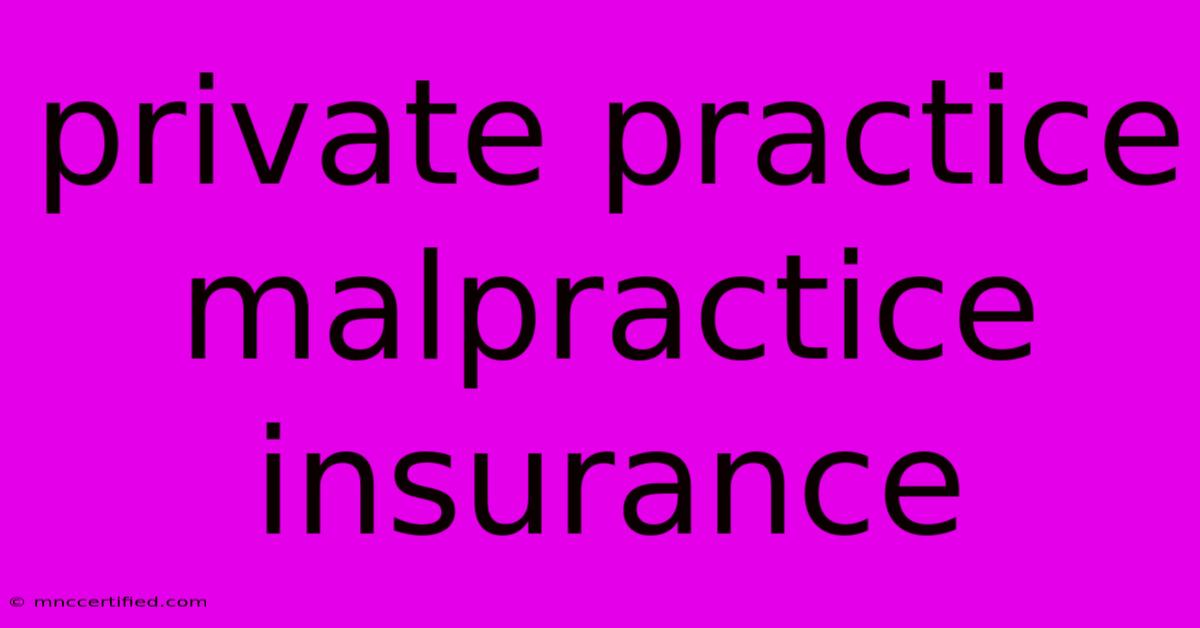Private Practice Malpractice Insurance

Table of Contents
Safeguarding Your Practice: A Guide to Private Practice Malpractice Insurance
As a healthcare professional operating in private practice, your reputation and financial security are intertwined with the quality of care you provide. A single medical error could lead to a malpractice claim, potentially jeopardizing everything you've built. This is where private practice malpractice insurance comes in, acting as a crucial shield against financial ruin.
Understanding the Risks: Why Malpractice Insurance is Non-Negotiable
The healthcare landscape is complex, and even the most experienced professionals can face unforeseen circumstances. Here's why malpractice insurance is essential for private practices:
- Medical Errors: Mistakes happen, and even minor errors can lead to serious consequences for patients. This can result in lawsuits seeking compensation for medical expenses, lost wages, and pain and suffering.
- Patient Misunderstandings: Communication breakdowns can lead to patient dissatisfaction and potential legal action.
- Changing Medical Standards: The practice of medicine is constantly evolving, and staying abreast of the latest standards is crucial to avoid negligence claims.
Tailoring Your Coverage: Choosing the Right Private Practice Malpractice Insurance
Not all malpractice insurance policies are created equal. When choosing the right coverage, consider these factors:
1. Coverage Limits: This determines the maximum amount your insurance company will pay for a covered claim. Ensure your policy's limits are sufficient to cover potential liabilities.
2. Coverage Types:
- Claims-Made: Covers claims made against you during the policy period, regardless of when the incident occurred.
- Occurrence: Covers incidents that occurred during the policy period, even if the claim is made later.
3. Additional Coverages: Consider options such as:
- Tail coverage: Extends your policy's coverage period beyond its expiration date, protecting you from claims arising from past incidents.
- Defense costs: Covers legal fees and other expenses associated with defending a malpractice claim.
- Medical records security: Protects you from claims arising from breaches of patient privacy.
4. Premium Rates: Compare quotes from various insurance providers and consider factors like your specialty, practice location, and claim history.
Finding the Right Provider: Tips for Effective Search
1. Seek Recommendations: Network with colleagues and professional organizations to gather recommendations for reputable insurance providers. 2. Research and Compare: Obtain quotes from multiple insurers and carefully review their policy terms and conditions. 3. Consider Specialty Providers: Some insurance companies specialize in providing malpractice insurance to specific medical professions.
Beyond Insurance: Proactive Risk Management Strategies
While malpractice insurance provides financial protection, proactive risk management strategies can minimize the likelihood of claims altogether.
- Maintain Thorough Documentation: Accurate and complete medical records are crucial for defending against malpractice claims.
- Communicate Effectively: Clearly explain diagnoses, treatment plans, and potential risks to patients.
- Stay Updated: Continue your education to stay informed about evolving medical standards and best practices.
Conclusion: Protecting Your Legacy
Private practice malpractice insurance is an essential investment in your professional future. It safeguards your financial security, provides peace of mind, and allows you to focus on providing the best possible care to your patients. By carefully selecting the right policy and practicing sound risk management strategies, you can build a thriving practice while minimizing your exposure to potential liabilities.

Thank you for visiting our website wich cover about Private Practice Malpractice Insurance. We hope the information provided has been useful to you. Feel free to contact us if you have any questions or need further assistance. See you next time and dont miss to bookmark.
Featured Posts
-
June Spencer Archers Star Dies At 105
Nov 09, 2024
-
Ucla Defeats Iowa Despite Offensive Woes
Nov 09, 2024
-
Annexus Retirement Investment Products
Nov 09, 2024
-
World Cup Quarterfinal Irelands Painful Defeat
Nov 09, 2024
-
Cold Email Template Investment Banking
Nov 09, 2024